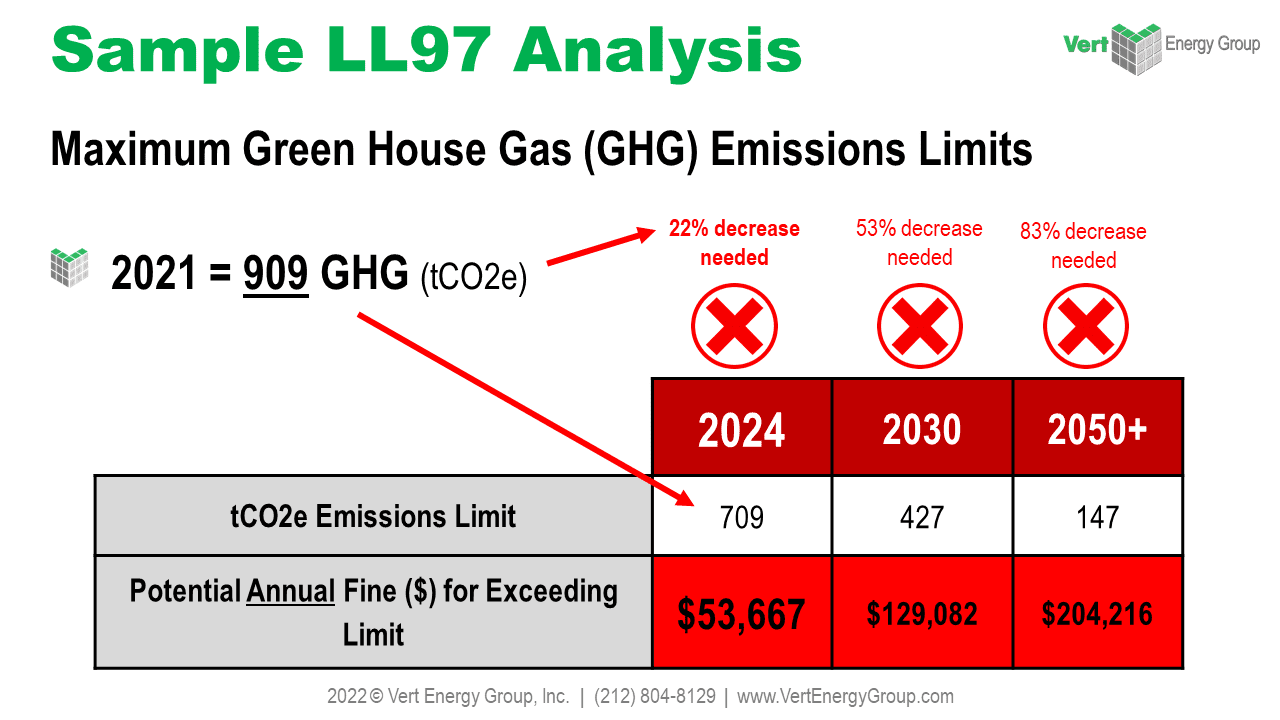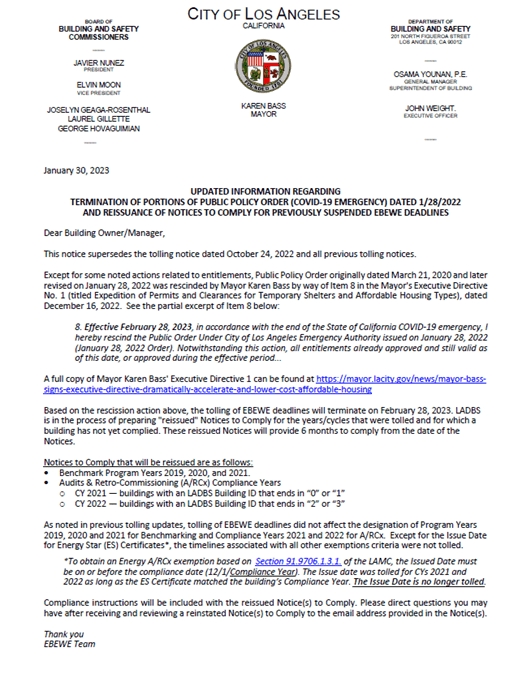New York City Local Law 97 is a subset of the Climate Mobilization Act, a groundbreaking piece of legislation aimed at reducing greenhouse gas emissions in the city. Mayor de Blasio has pledged to address these emissions as part of his plan to make the city carbon neutral by 2050. The goal of Local Law 97 is to reduce greenhouse gas emissions produced by New York City’s largest buildings by 40% by 2030 and 80% by 2050. Buildings account for approximately two-thirds, or 70%, of New York City’s total greenhouse gas emissions making them a critical area for reduction.
Local Law 97 (LL97) is a green energy policy that requires most buildings over 25,000 square feet to meet new energy efficiency limits and reduce their greenhouse gas emissions by 2024, with even stricter limits coming into effect by 2030. Local Law 97 generally covers the following buildings, with some exceptions:
• Buildings that exceed 25,000 gross square feet
• Two or more buildings on the same tax lot that together exceed 50,000 square feet
• Two or more buildings owned by a condo association that are governed by the same board of managers and that together exceed 50,000 square feet

LL97 requires buildings to meet specific emissions limits, which vary based on the type of building and its occupancy. The limits are expressed in pounds of carbon dioxide equivalent per square foot per year (CO2e/sf/yr). Building owners who fail to comply with Local Law 97 will face significant penalties. The penalty for non-compliance is $268 per metric ton of CO2e which exceeds the building’s emissions limit. For a building that is 50,000 square feet and exceeds its emissions limit by 100 metric tons of CO2e, the penalty would be $26,800 per year. The penalties can add up quickly, making compliance a top priority for building owners and operators.
• 1st Deadline is 2024 (+ additional 40% reduction required by 2030.)
• Penalty for non-compliance: $268 per metric ton over the limit
The first compliance deadline is quickly approaching, and building owners and operators must act quickly to ensure compliance. Here’s why:
• 2022 = Plan & Implement Energy Upgrades
• 2023 = Plan & Implement Energy Upgrades (Last chance to make upgrades)
• 2024 = 1 full year of proven energy reduction
• 2025 = Will determine if you are in compliance based on the 2024 Benchmark Report
Local Law 97 is one of the most ambitious plans for reducing emissions in the nation, and to comply with LL97, building owners and operators must take a multi-pronged approach. The first step is to benchmark the building’s energy consumption and compare the building’s energy use to that of similar buildings. Building owners must submit this benchmarking data annually to the city, as required by Local Law 84. Local Law 84 requires that property owners submit a Benchmarking report annually for all properties over 25,000 square feet to adjust any areas of excessive energy consumption data or mismanagement.
Local Law 88, imposed by the department of buildings in NYC, established lighting upgrade and submetering requirements. Local Law 87 mandates buildings over 50,000 gross sq. ft. to undertake intensive yet periodic energy audits and retro-commissioning measures. Building owners must conduct an energy audit and submit an Energy Efficiency Report every 10 years that outlines any energy savings opportunities found during the energy audit. Conducting an energy audit is the second step in complying with LL97 and is used to identify opportunities for energy efficiency improvements.
The audit must be conducted by a qualified professional and must comply with the requirements of Local Law 87 and will identify energy-saving measures that can be implemented to reduce the building’s emissions. Once the energy audit is complete, building owners must develop an emissions reduction plan that outlines the measures they will take to comply with Local Law 97. The plan must be submitted to the city for approval, and owners must implement the measures within a certain timeframe. This is why it is imperative you move quickly to complete your energy audit, submit plans to the city for approval (which can be time consuming) with enough time left to complete any upgrades prior to 2024, wherein you must have a full year of proven energy reduction. Some of the measures that can be implemented to comply with Local Law 97 include upgrading building systems such as heating, ventilation, and air conditioning (HVAC), installing energy-efficient lighting, and improving building insulation. Building owners may also consider installing renewable energy systems such as solar panels or wind turbines to generate clean energy on-site.

We asked experts in the field for insight into how Local Law 97 is affecting building owners and managers in terms of compliance and the difficulties in meeting the requirements of this law.
“The first thing to grasp about this law is -does it, and to what extent affects you and your building. We began working with the planning and contributions to this local law nearly a decade ago. Local law 97 was since amended numerous times but formally in 2019 through the changes made by local law 147… After understanding if and to what extent this law affects you, the next step is to fully consume how and what changes are required so you can develop a phased strategy…In addition to these (described above) measurements there are required prescriptive or preventive and proactive activities. Some of these include:
• Adjusting temp set points for heat and hot water
• Reporting all heating system leaks
• Maintaining a clean heating system in good operating condition
• Installing insulation and temp controls for radiating heat units, and steam condensate tanks
• Replacing or repairing steam traps
• Indoor and outdoor heating system sensors for efficient temp control, proper set points in boiler operations
• Upgrading legacy lighting systems to energy efficient systems
• Weatherization and air sealing ducts, building envelopes and points of fenestration.
• Installing timers on exhaust fans
• Installing radiant barriers behind all radiators
The city has set up parameters for forming a team of capable professionals and how to submit proof of scope completed. It is important to recognize a lack of submittal in addition to a false submittal accrue significant fines. False submittal have fine amounts of up to 500,000 and max fines include potential 30 day imprisonment. These laws are best phases and pre planned to spread costs across available budget.
We typically see our clients pairing our lighting conversions with longer yield projects to immediately begin accruing energy savings as an offset. In general this law deals with reducing the energy consumption footprint within these systems HVAC, hot water, conveyance, lighting, electrical systems. We work strategically with our clients to maximize the impact of return on each dollar spent making these advances.” – K.A. Stacie Alexiou | Certified Energy Manager and CEO of WATT + FLUX
“From our perspective as experts in the boiler and heating industry, compliance with LL97 has been challenging. There are some relatively economical solutions for building owners to reduce their boiler emissions, such as pipe insulation, new steam vents, lowering the steam pressure, and tuning burners. The issue is that the savings from these solutions do not come close to the aggressive emission targets outlined in LL97. To approach the targets, you may have to install a high-efficiency boiler or replace your current fossil fuel system with an electric alternative. Installing a new boiler today in a large building could cost over $100,000. Even with a new boiler, there is no guarantee that the new boiler will hit the LL97 target.
In some cases, the property owners remove their boilers and current heating system in favor of an electric system. Though this may work in some instances, there are many reasons why this is not practical. Running the outdoor condensers and refrigerant piping destroys the aesthetic of the building facade. Finding the internal space for the indoor blowers in every room is also challenging. Some buildings lack the electrical power to support electric heating systems.
NYC building owners are already under pressure due to existing regulations. Unless the electric heating technology advances, complying with LL97 will be a significant challenge.” –Vincent Caputo, Insparisk LLC
Building owners and operators must take swift action to comply with the law’s emissions limits and avoid substantial fines. Get started on your compliance before it’s too late by scheduling a free consultation with a project advisor. Learn all the details of New York’s Local Law 97 and discuss best practices for improving your buildings’ energy efficiency. We can also get you multiple bids from various contractors, engineers, and specialists in our network. Schedule a consultation to see how VertPro® can help you execute your building’s upgrades and meet compliance for LL97.
“Building owners are enthusiastic in my experience as the NYS and NYC Govts have put in place numerous incentives that are quite rich at the moment to help with compliance. Additionally, they are happy the changes will save them money long term” -Anthony Pereira: altPOWER
Why You Should Start Your Benchmark Earlier
 As the world moves towards a more sustainable future, energy benchmarking has become an essential tool for businesses and organizations looking to reduce their carbon footprint and save on energy costs. Energy benchmarking involves measuring and tracking a building’s energy usage over time and comparing it to similar buildings to identify opportunities for improvement. This can be a complicated process, especially if you’re benchmarking a large building or facility, as it requires gathering and analyzing a large amount of data, as well as interpreting that data in a meaningful way. If you are about to start energy benchmarking, here’s a few reasons why you should start sooner rather than later.
As the world moves towards a more sustainable future, energy benchmarking has become an essential tool for businesses and organizations looking to reduce their carbon footprint and save on energy costs. Energy benchmarking involves measuring and tracking a building’s energy usage over time and comparing it to similar buildings to identify opportunities for improvement. This can be a complicated process, especially if you’re benchmarking a large building or facility, as it requires gathering and analyzing a large amount of data, as well as interpreting that data in a meaningful way. If you are about to start energy benchmarking, here’s a few reasons why you should start sooner rather than later.
• Identifying inefficiencies early can save you money – The earlier you start benchmarking your building’s energy usage, the sooner you’ll be able to identify any inefficiencies and start taking action to address them. This can save you money on energy costs in the long run, as well as help you avoid costly repairs or upgrades down the line.
• It’s easier to implement changes when you have a baseline- By starting your energy benchmarking early, you’ll be able to establish a baseline for your building’s energy usage. This will make it easier to track changes over time and determine whether the changes you make are having a positive impact. It will also help you set realistic goals for reducing energy usage and establish a plan of action for achieving those goals.
• You’ll be better prepared for future regulations- As governments around the world continue to implement regulations aimed at reducing greenhouse gas emissions, energy benchmarking is likely to become a requirement for many businesses and organizations. By starting your energy benchmarking early, you’ll be better prepared for any future regulations that may be implemented in your area.
• You’ll be doing your part to help the environment- Reducing energy usage is one of the most effective ways to reduce greenhouse gas emissions and combat climate change. By starting your energy benchmarking early, you’ll be doing your part to help the environment and contribute to a more sustainable future.
Ready to Start Benchmarking? Here’s what you need to know:
One of the biggest challenges of benchmarking is gathering accurate and reliable data. This typically involves working with utility companies to obtain data on a building’s energy usage, which can be a time-consuming process. In some cases, utility companies can take 4-6 weeks or longer to send their data, which can delay the benchmarking process and make it more complicated, especially if you are required to comply by a specific deadline.
The amount of time it takes to request utility forms for an energy benchmark can vary depending on several factors, including the specific utility company, the type of forms needed, and the method of request. In some cases, utility forms may be available online and can be downloaded and submitted immediately. In other cases, it may be necessary to contact the utility company directly to request the forms, which can take several weeks to receive. Once the forms have been requested and received, the time required to complete the energy benchmarking process will depend on the specific requirements of the analysis. Basic benchmarking analysis may only require a few weeks to complete, while more comprehensive analysis may take several months or longer.
It is important to note that some utility companies may require additional information or documentation before providing the forms, which can add to the time required for the request. Additionally, if there are errors or discrepancies in the data provided on the forms, it may be necessary to request additional information or clarification, which can further delay the energy benchmarking process. To minimize delays and ensure a smooth and efficient energy benchmarking process, it is recommended to plan ahead and allow plenty of time for requesting and receiving utility forms. It may also be helpful to work with a qualified energy consultant or service provider who has experience with the energy benchmarking process and can help to streamline the data collection and analysis process.
Another challenge of benchmarking is ensuring that the data you collect is accurate and reliable. This requires careful attention to detail and the use of specialized software and tools to analyze the data and identify patterns and trends. Interpreting the results of the benchmarking process can be challenging, as there are many factors that can influence energy use. For example, a building located in a hot climate may use more energy for cooling than a building located in a cooler climate. Similarly, a building that is used primarily during the day may use more energy for lighting than a building that is used primarily at night. To account for these and other factors, it may be necessary to perform a more detailed analysis of the data. This could involve the use of sophisticated software tools that can model the building’s energy use and simulate different scenarios.
In addition to analyzing the data, it is also important to act based on the results of the benchmarking process. This may involve making changes to the building or facility to reduce energy use, such as upgrading to more energy-efficient equipment or improving insulation. Overall, energy benchmarking is a complicated process that requires a thorough understanding of building systems and energy use. It can be an important tool for identifying opportunities for energy savings, but it must be done carefully and accurately to produce meaningful results.
Keeping up with various energy benchmarking regulations across the country can be complex and time-consuming. Energy Benchmarking does not have to be hard. VertPro® is proud to provide a Group Webinar on March 15th, 2023. This educational webinar discusses Evolving Energy Benchmark Requirements, 6 Common Pitfalls to Avoid in Benchmarking and Best Practices to Plan for 2023. Experts in Energy Benchmarking will show you how to complete a Benchmark, why it is important, who enforces it, and how VertPro® can help you with compliance. Sign up now for this educational Group Webinar on March 15, 2023 to learn more!
Despite these challenges, benchmarking can be a valuable tool for businesses and organizations looking to reduce their energy usage and carbon footprint. While it can be a complicated process that requires careful attention to detail and specialized tools and software, by identifying inefficiencies and areas for improvement, benchmarking can help businesses save money on energy costs, reduce their environmental impact, and improve the overall performance of their buildings and facilities.
LA EBEWE Rescinds Tolling

The LA EBEWE (Existing Buildings Energy and Water Efficiency) ordinance is a regulation passed by the city of Los Angeles, California, that aims to improve the energy and water efficiency of existing buildings in the city. As part of the ordinance, building owners are required to submit an annual report on their building’s energy and water usage, known as the EBEWE report.
In response to the COVID-19 pandemic, the city of Los Angeles issued an emergency order in March 2020 that tolled (i.e., paused) the deadline for building owners to submit their 2019, 2020, and 2021 EBEWE Benchmark and A/RCx reports. This was done to provide relief to building owners who were facing difficulties in meeting the original deadline due to the pandemic.
On February 28, 2023, the city of Los Angeles rescinded the tolling order, which means that the deadline to submit has been re-enacted. LADBS is in the process of preparing “reissued” notices to comply for the years/cycles that were tolled and for which a building has not yet complied. These reissued notices will provide 6 months to comply from the date of the Notices. This means building owners who have not yet submitted their benchmark reports for 2019-2021 are now required to do so within 6 months of receiving a reissued notice.
Notices to comply that will be reissued are as follows:
• Benchmark Program Years 2019, 2020, and 2021.
• Audits & Retro-Commissioning (A/RCx) Compliance Years
• CY 2021- buildings with an LABDS Building ID that ends in “0” or “1”
• CY 2022-buildings with an LABDS Building ID that ends in “2” or “3”
As a business owner in the Los Angeles area, you may be aware of the requirement for energy audits under the Los Angeles Existing Buildings Energy and Water Efficiency (EBEWE) program. As the tolling has been rescinded the deadline for energy audits that were due in 2021 and 2022 (with the above buildings ID’s) has been updated to September 2023.
It’s worth noting that the LA EBEWE ordinance is an important tool in the city’s efforts to reduce greenhouse gas emissions and combat climate change. By requiring building owners to report on their energy and water usage, the city can identify areas where improvements can be made and encourage building owners to take steps to reduce their carbon footprint.
Rescinding the tolling order is an important step in ensuring that building owners are held accountable for their energy and water usage and that the city can continue to make progress in its efforts to promote sustainability. While it may be an inconvenience for some building owners, it’s a necessary step in the fight against climate change. If you have not signed up for your initial site inspection for your 2021 or 2022 energy audit, do so now: EBEWE LA’s Existing Buildings Energy & Water Efficiency Program (vertpro.com), as scheduling will be limited and assigned by first come, first served. Don’t miss the upcoming compliance deadline! See below for the complete City notice:

“LOSE AN HOUR IN THE MORNING, AND YOU WILL BE ALL DAY HUNTING FOR IT.― RICHARD WHATELY”
History Behind the Blarney Stone

If you’ve ever been to Ireland or read about its folklore, you’ve likely heard of the Blarney Stone. This mystical rock is said to give those who kiss it the gift of eloquence and the ability to persuade with words. But what is the Blarney Stone, and why is it so famous?
The Blarney Stone is a block of limestone that is part of the battlements of Blarney Castle in County Cork, Ireland. The origins of the stone are shrouded in mystery, but it is said to have been brought to Ireland from the Holy Land during the Crusades. Legend has it that the stone was originally part of Jacob’s Pillow, which Jacob rested his head on when he dreamt of the ladder to heaven in the Bible.
The Blarney Stone has been the subject of countless myths and legends over the centuries. One story says that the stone was once used as a seat by the goddess Cliodhna, who gave it to Cormac McCarthy, the king of Munster, in gratitude for his kindness. Another tale tells of a witch who was saved from drowning by a king, who then rewarded him with the stone.
The tradition of kissing the Blarney Stone dates back to the 16th century. It is said that Queen Elizabeth I of England sent her envoy to Ireland to demand that the Irish chieftains submit to her rule. The chieftain of Blarney Castle, Cormac Teige McCarthy, was a skilled diplomat and managed to evade the envoy’s demands with his persuasive words. In appreciation, Queen Elizabeth I is said to have declared that anyone who visited Blarney Castle and kissed the stone would be blessed with the gift of eloquence.
Today, visitors to Blarney Castle can climb to the top of the castle’s tower and lean backward over a parapet to kiss the Blarney Stone. It’s not an easy feat – the stone is located about 20 feet above the ground, and kissing it requires a certain amount of bravery and flexibility. But those who manage to do so are said to be granted the “gift of the gab” – the ability to speak persuasively and convincingly.
Of course, the idea that kissing a stone can give you the gift of eloquence is purely a myth. There’s no scientific evidence to support the claim. But that hasn’t stopped millions of visitors from all over the world from making the journey to Blarney Castle to kiss the stone.
The Blarney Stone is a fascinating piece of Irish folklore. Whether you believe in its powers or not, it’s worth a visit to Blarney Castle to see it for yourself. And who knows – maybe you’ll be inspired to give a stirring speech or win an argument after you’ve kissed the stone!
Fun Fact: NYC is the most linguistically diverse city in the world.
One of the most amazing facts about New York City is that it’s the most linguistically diverse city in the world. New Yorkers speak over 800 languages, and four in ten households speak at least one language other than English. After English, the top spoken languages are Spanish, Chinese, Russian, and Italian. Of the five boroughs, Queens is the most linguistically diverse neighborhood, not just in NYC but in the world. Source

Stephanie’s Section
Chat GPT
Chat GPT, a growing phenomenon has the masses divided. Will it enhance or ruin? Let’s discuss…from a unique perspective. ChatGPT: A Breakthrough in Natural Language Processing
Artificial intelligence (AI) has made significant strides in recent years, with applications ranging from self-driving cars to image recognition. One area that has seen significant progress is natural language processing (NLP), which aims to enable computers to understand and generate human-like language. ChatGPT, a language model developed by OpenAI, represents a breakthrough in this field.
At its core, ChatGPT is a deep learning algorithm that has been trained on vast amounts of text data to learn the patterns and structures of natural language. This training process enables ChatGPT to understand the context and meaning behind text-based conversations and generate responses that are fluent and coherent, often indistinguishable from those of a human. This is achieved through a technique called transformer-based language modeling, which allows the model to consider the entire context of the conversation and generate responses that are appropriate and relevant.
One of the most significant features of ChatGPT is its ability to learn from vast amounts of data, which enables it to continually improve its responses over time. This means that the more data that is fed into the model, the better it becomes at generating accurate and relevant responses.
The applications for ChatGPT are numerous and varied. One of the most common uses is in chatbots, which are automated systems that can interact with users through text-based conversations. By integrating ChatGPT into chatbots, businesses can provide more efficient customer service and reduce the need for human operators. Chatbots can also be used to assist with tasks such as appointment scheduling and order tracking.
Another application of ChatGPT is in language translation. By training the model on multiple languages, it can be used to translate text between different languages, enabling users to communicate with people who speak different languages. This can be especially useful for businesses that operate in multiple countries or for individuals who travel frequently.
ChatGPT can also be used for content creation by generating text based on a given prompt. This can be useful for writing articles, social media posts, and other forms of content. By generating content that is relevant and engaging, businesses can improve their online presence and attract more customers.
In addition to its practical applications, ChatGPT represents a significant step forward in our understanding of natural language processing. By developing a language model that can generate human-like responses, we are one step closer to achieving true artificial intelligence.
However, as with any technology, there are also potential risks associated with the use of ChatGPT. One concern is that the model may be used to generate fake news or propaganda, which could have serious consequences for society. Additionally, there is the risk of bias in the training data, which could result in the model generating responses that are discriminatory or offensive.
Overall, ChatGPT represents a significant advancement in the field of natural language processing and has the potential to revolutionize the way we interact with computers and technology. While there are certainly risks associated with its use, the benefits of this technology are clear, and it is likely that we will see continued development and refinement of language models like ChatGPT in the years to come.
I asked ChatGPT to “Write an article explaining ChatGPT from your perspective” and you just read what it came up with. After reading, what do you think? Scary? Life Changing? Ahead of its time? You tell us.
 Search by Zip to Find Applicable Energy Laws
Search by Zip to Find Applicable Energy Laws
There are over 30 cities/states with Energy Benchmark requirements - 16 have Energy Audit requirements as well! Use this free tool to check if your building has an upcoming Energy Benchmark or Energy Audit deadline.
FIND OUT HERE »
